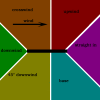EdFred
Taxi to Parking
If you're coming from a direction on the opposite side of the airfield as the pattern, once you cross over the field you'll have to reverse your course to pick up the 45. At some point prior to reversing your course, the runway and any pattern traffic will be behind you as you maneuver to get on the 45 headed back to the airfield.
If you're approaching the airfield from the same side as the pattern, you are correct in thinking that everything is in front of you as you enter via a 45. That's why Ed said he only enters via a 45 if he happens to be approaching the airfield conveniently aligned for the 45.
This.
That's not the only option. If you're on the opposite side, why not enter an upwind leg, then enter crosswind?
You have even more time to observe the pattern.
This.
I agree and that's often how I enter the pattern. I was just trying to clarify EdFred's post.
This.
Here's what I tend to do (assuming left traffic and no terrain issues):


 Others just seem to ignore the border. Which would be legal if they were in contact with ATC, had the appropriate transponder code, had a medical, etc., but I'm willing to bet...
Others just seem to ignore the border. Which would be legal if they were in contact with ATC, had the appropriate transponder code, had a medical, etc., but I'm willing to bet...


 You've learned the most important lesson of all from this discussion. Good on ya!
You've learned the most important lesson of all from this discussion. Good on ya!